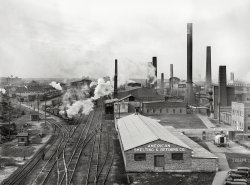
MAY CONTAIN NUTS

Search Shorpy
SHORPY ART

Framed or unframed, desk size to sofa size, printed by us in Arizona and Alabama since 2007. Explore now.
Join and Share
Ad-Free Shorpy
Shorpy is funded by you. Patreon contributors get an ad-free experience.
Learn more.

Recent comments
- Recent view
- Hudson’s Big Store
- Say what??
- Grapes?!
- A Beautiful Moment
- Such joy
- Bethune-Cookman University today...
- Yellow sky at morning
- Side Winder
- Air Quality?
- Sojourner Truth riot
- None were so blind(ed)
- The less famous sister
- Good ol' days?
- Rise and Fall
- Goo Goo Ga Joob
- Ticket Retention
- Not the only one
- Vagaries of War
- Killed by Amtrak
- Back to the Future
- Wanted --
- If you can't stand the light
- Centralized Traffic Control, I believe
- What's really happening
- Heckuva remote control!
- Sometimes — Things Go Bump!
- I SEE THE LIGHT
- Union Switch and Signal Company
- Get That Light Out Of My Eyes
Member Photos
The Shorpy
Print Emporium
Print Emporium
Search Shorpy
Search results -- 30 results per page
- Cane: 1938
- January 1938. "Train loaded with cane on a sugar plantation near Ponce, Puerto Rico." Nitrate ... Posted by Dave - 03/06/2019 - 11:34am -
![Cane: 1938 January 1938. "Train loaded with cane on a sugar plantation near Ponce, Puerto Rico." Nitrate negative by Edwin Rosskam. View full size.
Flag Cars?I think you mean flat cars. A lot of sugar plantations - at least in Hawaii - had their own narrow gauge railroads to carry the cut cane from the fields to the processing plants.
[The L.O.C. record of the photographer's caption for this image says "flag cars," two words. - Dave]
(The Gallery, Agriculture, Edwin Rosskam, Puerto Rico)](https://www.shorpy.com/files/images/8b30718u.thumbnail.jpg)
- Serious Fun: 1942
- ... they all look like a scene from Hitchcock's Strangers on a Train.
(The Gallery, Russell Lee) ... Posted by Dave - 03/13/2016 - 8:51pm -
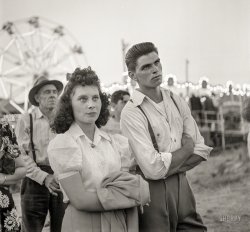
- N.Y. See: 1925
- ...
The Kramdens' apartment or, add an elevated train track and you've got Elwood Blues'.
Chauncey Street Take away the ... Posted by Dave - 05/16/2018 - 12:35pm -
![N.Y. See: 1925 "New York Window." Glass transparency by Margaret Watkins, exhibited at the 2nd International Salon of Pictorial Photography in 1925. View full size.
Before HitchcockThis picture is reminiscent of the film "Rear Window" and if you live in NYC (or any big city with buildings arranged like this) you cannot help but see into your neighbors' apartments and lives, especially if they keep their windows uncovered.
While visiting relatives in New York for Christmas a few years back, we were unintentionally witnesses to seeing a family directly across the alley from us having their holiday celebration in their beautifully furnished and decorated living quarters since they constantly kept their lights on and their windows uncovered.
We made an effort not to look and felt like snoops, but it would be dark there by 4 or 5 and they'd have their place all lit up. I can see how someone who couldn't leave their house would be drawn into the neighbors' business though and it was not a comfortable feeling. Talk about life in a fishbowl. Seemed like a very nice family though.
I know it is easy to say "Just don't look over there" but with the placement of the buildings it was really unavoidable.
[Until the binoculars broke. - Dave]
Could be worseActually, in New York, this would be advertised as a "view apartment." Some people have a view of a brick wall across the air shaft.
Actually, this view is kinda picturesque -- almost looks like a European village scene.
The Kramdens' apartmentor, add an elevated train track and you've got Elwood Blues'.
Chauncey StreetTake away the curtains and flowers and you have the Kramdens' apartment
(The Gallery, NYC)](https://www.shorpy.com/files/images/SHORPY-03186u.thumbnail.jpg)
- New 737: 1969
- ... Daylight, particularly the steam locomotives for that train. I looked on Air Cal's Wikipedia page for some sort of connection between ... Posted by Islander800 - 12/14/2012 - 8:20pm -
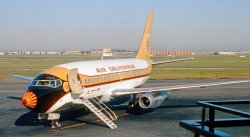
- Masques de Guerre: 1918
- ... So for two years through their bandages they watch the train pull out for Blighty, while the damage which was done them in the ... Posted by Dave - 01/09/2018 - 2:56pm -
![Masques de Guerre: 1918 August 1918. "Mutiles. Paris, France. Masks showing different stages in the work done by Mrs. Anna Coleman Ladd of the American Red Cross for soldiers whose faces have been mutilated in the war. The upper row shows casts taken from the faces as they actually are, the lower row shows the faces which Mrs. Ladd has modelled on the foundation of the life mask with the help of photographs taken before the wound was received & on the table may be seen some of the final masks made for fit over the disfigured part of the face & colored as exactly as possible like life." 5x7 glass negative by Henri A. Coles for the ANRC. View full size.
Trench warfareSerious wounds to the head and face were not uncommon during the First World War, particularly on the Western Front where grueling trench warfare slogged on for years. Soldiers who peeked over the top of the trench were often picked off by snipers on the opposing side.
Head wounds were often fatal but facial wounds frequently resulted in terrible disfiguremrnt. In the days before plastic surgery was common, masks like these made it possible for a wounded veteran to appear in public without being stared at.
For the full story, the Smithsonian Magazine has a fascinating and detailed article on Anna Coleman and her labor of love in its archives.
Face cases"The first morning [at the French base hospital] an officer came in to visit a friend; his face was entirely swathed in bandages, with gaps left for his breathing and his eyes. He had been like that for two years, and looked like a leper. When he spoke he made hollow noises. His nose and lower jaw and been torn away by an exploding shell. Little by little, with infinite skill, by the grafting of bone and flesh, his face was being built up. Could any surgery be more merciful?
"In the days that followed I saw several of these masked men. The worse cases were not allowed to walk about. The ones I saw were invariably dressed with the most scrupulous care in the smartest uniforms, Sam Browns polished and buttons shining. They had hope, and took a pride in themselves – a splendid sign!
"Perhaps you ask why the face-cases should be kept in France. I was not told, but I can guess – because they dread going back to England to their girls until they've got rid of their disfigurements. So for two years through their bandages they watch the train pull out for Blighty, while the damage which was done them in the fragment of a second is repaired."
-- From "The Glory of the Trenches," by Lieutenant Coningsby Dawson, Canadian Field Artillery, 1918.
(The Gallery, ANRC, WWI)](https://www.shorpy.com/files/images/SHORPY-17050a.thumbnail.jpg)
- Pennsy Parthenon: 1909
- ... in 1963, only the above ground portion was torn down. The train tracks and lower platforms still exist. This is now the site of Madison ... Posted by Dave - 03/31/2017 - 4:54pm -
![Pennsy Parthenon: 1909 Manhattan circa 1909. "New Pennsylvania Station, New York, N.Y." The Beaux-Arts behemoth whose demolition in 1963 lit a fire under the nation's armchair architects. 8x10 inch dry plate glass negative. View full size.
Hold your HorsesWhile I was working in the Hotel Pennsylvania (where that hole is in the foreground) a few years ago, I realized that the bulk of the construction material for the Station, and the hotel, were brought there by horse and wagon.
Now look at the size of the building materials.
Did you know?That it took about nine years to build the station. It was completed about a year after this picture was taken. The building itself covers about 8 acres and is about 1150 ft. tall. When the station was demolished in 1963, only the above ground portion was torn down. The train tracks and lower platforms still exist. This is now the site of Madison Square Garden and the Penn Hotel.
[Over a thousand feet tall? I definitely did not know that. - Dave]
The size of itThe size and scale of the building becomes really apparent when compared to the men working on the roof.
(The Gallery, DPC, NYC, Railroads)](https://www.shorpy.com/files/images/SHORPY-4a23399a.thumbnail.jpg)
- Telluride Tracks: 1940
- September 1940. "Narrow gauge railway yards, train and water tank at Telluride, Colorado." Medium format negative by Russell ... Posted by Dave - 06/22/2019 - 9:34am -
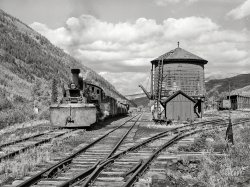
- Cozy Depot: 1943
- January 1943. "Freight train operations on the Chicago & North Western Railroad between Chicago ... ] waits at the little railroad station for a suburban train to take him back home to Chicago. A welder who works at the rip tracks is ... Posted by Dave - 01/08/2014 - 10:29am -
![Cozy Depot: 1943 January 1943. "Freight train operations on the Chicago & North Western Railroad between Chicago and Clinton, Iowa. At the end of the trip, conductor John Wolfsmith [last seen here] waits at the little railroad station for a suburban train to take him back home to Chicago. A welder who works at the rip tracks is trying to thaw out his frozen air hose." Medium-format negative by Jack Delano for the Office of War Information. View full size.
(The Gallery, Jack Delano, Railroads)](https://www.shorpy.com/files/images/SHORPY_8d24470a.thumbnail.jpg)
- Detroit during 1967 Riots
- ... Went with grandmother on a Norfolk and Western passenger train. Had just turned 12. Remember riding a bike down a street and being ... Posted by brianvnt90 - 08/17/2012 - 8:12pm -

- A Bird in the Pan: 1943
- ... cooks on dining cars, and also the excellent restaurants train passengers knew were in the Loop.
Sad to say, Union Station is all ... Posted by Dave - 11/22/2017 - 1:40pm -
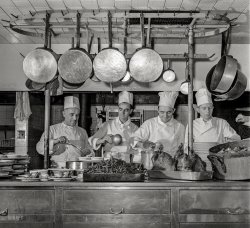
- Modern Signal: 1939
- ... in the dark with a truckload of flash apparatus. Oh, and a train might be nice, too.
The Rutland Road This is most likely the main ... Posted by Dave - 06/16/2018 - 5:08pm -
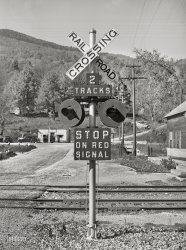
- Playing Along: 1958
- ... I see 3 rail track on the floor.
Somebody has a Lionel train just out of sight.
(Christmas, Kids, Pa. Kodachromes) ... Posted by Dave - 12/22/2013 - 1:36pm -
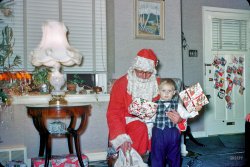
- Key System: 1939
- ... these tracks to the Transbay Terminal, the photo shows a train of the 3rd user, the Southern Pacific RR's Interurban Electric Railway ... Posted by tterrace - 05/20/2015 - 8:37am -
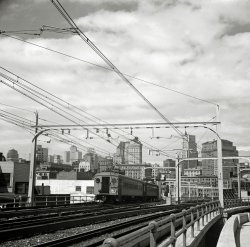
- Where I'm Coming From: 1943
- January 1943. "Freight train operations on the Chicago and North Western Railroad between Chicago and ... Posted by Dave - 03/24/2017 - 6:32pm -
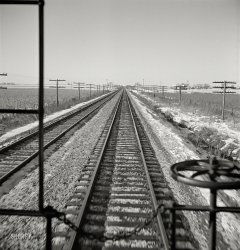
- Little Girl Blue: 1931
- ... as if she was sitting next to two strangers on a train while little Paulina looks like she's empty of feelings.
In their ... Posted by Dave - 09/27/2014 - 9:43am -
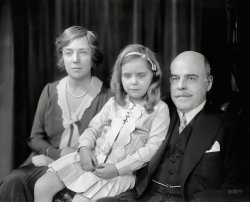
- First of the Mohicans: 1904
- ... at Caldwell just in time to catch the 11:25 am southbound train. She then left Caldwell to head back up to Ti at 2:45 pm and (once again ... Posted by Dave - 06/11/2016 - 8:02pm -
![First of the Mohicans: 1904 1904. "Sagamore Hotel dock, Green Island, Lake George, N.Y." 8x10 inch dry plate glass negative, Detroit Publishing Company. View full size.
SkiffsThose row boats are what we called St Lawrence skiffs when I was a kid. My family had a cottage on the St Lawrence River at Point Vivian, near the International Bridge. Our only boat was a double oar-lock skiff very similar to the ones pictured.
It was a beautifully made and maintained wooden boat, but I yearned for something with an outboard motor and drooled over the Chris-Crafts and other inboards seen at the public docks in Alexandria Bay!
Mohican I (1894 - 1908)"The first Mohican [shown here] was built in Lake George Village on Pine Point. She was launched in 1894, she was 93 feet long and 17 feet wide and weighed 150 tons (the current Mo weighs 200 tons). She was propelled by a single 200 horsepower steam engine which worked a single propeller.
"She wasn't originally built for the Steamboat Company, but she was later purchased by the company. The company then improved the main deck, added steam heating, carpeting, and toilets among other things.
"She sailed daily from Baldwin (Ticonderoga) at 7:20 am, stopping at all of the landings when signaled to, and arrived at Caldwell just in time to catch the 11:25 am southbound train. She then left Caldwell to head back up to Ti at 2:45 pm and (once again after making all her landings) arrived in Baldwin at 6:30 pm. During busy times in the summer, she also made stops in Paradise Bay and the Narrows.
"After 14 years of faithful service the Mohican (I) was retired on 1908, just as the new steel-hulled Mohican (II) was rolled into service to replace her. The first Mohican was dismantled in Ticonderoga that same year."
Source: Lake George Steamboat Company.
The Lake George Steamboat Company turns 200 years old in 2017.
The Mohican II, which is still in service and is on the National Register of Historic Places, also has the antlers mounted at the top of the wheel house. The Mohican II is shown in the first photo below, and the other photo shows another view of the Mohican I.
(The Gallery, Boats & Bridges, DPC)](https://www.shorpy.com/files/images/SHORPY-4a11456a.thumbnail.jpg)
- Orphan Odyssey: 1924
- ... that in addition to the "Opera House", where "we teach and train our children every thing necessary for first class Musical Comedy and ... Posted by Dave - 10/22/2015 - 12:29pm -
![Orphan Odyssey: 1924
23 Students Here After
Crossing Continent on Way to Florida.
The tourists' camp in East Potomac park has been temporarily converted into a school. Twenty-three children from 3 to 19 years of age, students of the Draper's Children's Home, of Des Moines, Wash., are making their home there after a five month's trip across the continent.
They left Des Moines in June in a caravan of sleeping trucks, kitchen wagons and closed automobiles, bound for Florida, where they will pass the winter. They arrived here Friday. H.M. Draper, superintendent, heads the school-caravan.
A tutor is with the caravan and the children have daily school sessions. The report of their progress is mailed back to the superintendent of schools in Spokane, Wash., where they normally attend.
Most of the children are musicians or singers. Saturday they serenaded The Washington Post and the District commissioners and they are planning outdoor concerts here for this week.
-- The Washington Post, Nov. 24, 1924
Nov. 25, 1924. Washington, D.C. "Orphans of Des Moines, Wash., at tourist camp." National Photo Company Collection glass negative. View full size.
"Children's Industrial Home of Des Moines"I wonder if they didn't go to school in Spokane, but had to report back to some sort of state education board? According to the Highline Historical Society, Des Moines had 4 room school house at this time. http://www.highlinehistory.org/PHOTO_COLLECTION_FINDING_AID.pdf
The Des Moines Historical Society has a fabulous monograph on the Draper's and their home. http://dmhs.org/monographs/draper-childrens-home.html Although it doesn't elaborate much on their traditional schooling, it does have some great insights into why all these orphans are musicians and singers. I love that in addition to the "Opera House", where "we teach and train our children every thing necessary for first class Musical Comedy and Vaudeville Entertainments" (as printed in a flyer c. 1915),there was an operating "Printing Plant" in which students did all the typesetting and printing for a monthly newsletter that they helped write. Not everyone was born to be an entertainer after all.
It seems like the Draper's really cared for the well being of these children and were obviously aware of the struggles that would face them after leaving an orphanage or other such institution.
Why Spokane?It strikes me as odd that they are reporting back to the Spokane school, which is on the opposite side of the state from Des Moines. In 1924 it was a 2 day trip from one to the other (according to my mom, who did it back then).
[They're reporting back to Spokane because that's where they go to school, according to the news item. - Dave]
(The Gallery, Cars, Trucks, Buses, D.C., Kids, Music, Natl Photo)](https://www.shorpy.com/files/images/SHORPY-26473u.thumbnail.jpg)
- Paris Wheel
- ... at the cars on the Ferris Wheel. They're huge--like small train cars almost--exactly what I imagined the cars on the original Ferris ... Posted by LindseyKBrennan - 07/10/2008 - 11:39pm -
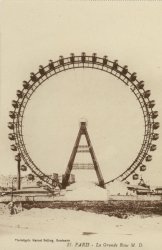
- Hanging at Rainbow Ridge: 1976
- ... the loading area for various incarnations of a miniature train ride. Some of it remains in the current version at the start of the Big ... Posted by tterrace - 07/27/2015 - 5:42am -
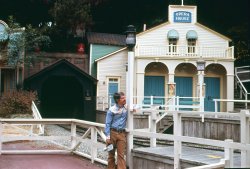
- Downtown Atlanta (Colorized): 1864
- ... of right half .
The title is “Atlanta, Ga. Wagon Train on Marietta Street”; however, this is in error. In fact, it was ... Posted by Rob - 08/24/2011 - 8:44am -
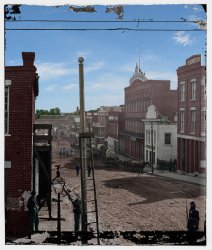
- Heaven and El: 1905
- ... standing While the church still stands the elevated train tracks were taken down in the late 1980's.
(The Gallery, Boston, DPC, ... Posted by Dave - 08/06/2017 - 8:54am -
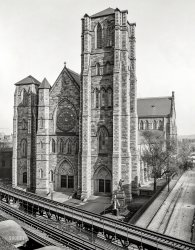
- Utah Copper: 1942
- ... 1942. "Utah Copper -- Bingham Mine. Brakeman of an ore train at the open-pit mining operations of Utah Copper Company at Bingham ... Posted by Dave - 08/03/2017 - 4:34pm -
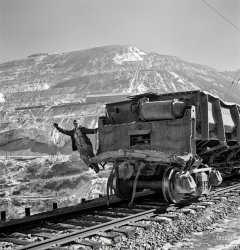
- Hamming It Up: 1951
- ... Then the most frightening ride was the old passenger train on which actors boarded and staged a train robbery. This had to be discontinued though because of a 'heart attack' ... Posted by woodchuck - 12/29/2009 - 4:57pm -
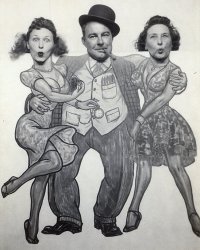
- California Western Railroad
- The station for the "Skunk Train" in Fort Bragg, California. One of many Kodachromes taken by Ruth Cooper, ... in 1923-24. The soft yellow with added "Skunk" train emblem and railroad name on the crest of the roofline came with the ... Posted by d4xycrq - 02/07/2014 - 7:57pm -
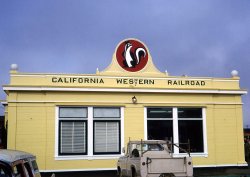
- Full Steam Ahead: 1913
- ... a lever is swung into the first car from the side. As the train moves the lever pries the rock out of the cars to the open side. In ... Posted by Dave - 08/18/2014 - 4:59pm -
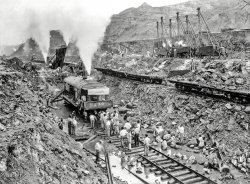
- Sunset on Fotomat: 1978
- ... Fotomate just a year before this! I had worked hard to train for it, and it was a pretty good job, overall. I had only worked there ... Posted by rizzman1953 - 10/20/2012 - 1:25pm -
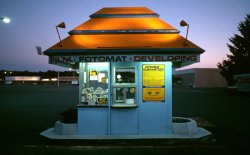
- King George V and Queen Mary
- ... nose. I had a good view of him when he passed in the train. We all lined the track and cheered him as he slowly went by looking very ... Posted by erilor - 06/13/2014 - 8:32pm -
![King George V and Queen Mary King George V and Queen Mary attending a military function, accompanied by Canadian Army officers (notice the maple leaf cap badges of the officers standing behind the VIPs). The reverse of the photo is stamped "Geo. Collard, Press Photographer, 19, Hartfield Crescent, Wimbledon, S.W. 19". This photo belonged to my great-grandfather Frank H. Briggs of Hamilton, Ontario, who was a dentist in the British Army. Not sure of the date, but judging by the King's appearance, probably the 1930s (he died in 1936). View full size.
Probably before 1921This photo was taken during 1902-1921. The officers are wearing their rank on the sleeve cuffs, except for the King and the generals who wear their rank on their shoulders. This system was changed in 1921 when all officers began wearing rank on their shoulders. Also, the dresses and hats of the women look pre-1920.
Regarding the King, his expression suggests, "Another endless parade".
UpdateSince submitting the photo, I've uncovered a bit more information. I believe it was taken on 4 February 1915 during WW I when the King reviewed 30 000 troops of the Canadian Division on Salisbury Plain in England, prior to their embarkation for the continent. Secretary of State for War Lord Kitchener was also present at the review - that may be him seated to the left of the Queen.
This would be consistent with DoninVa's comment below.
[It's not Kitchener. -tterrace]
Very depressedI would very much like to know the identity of the fellow with the white moustache sitting to the left of Queen Mary. I considered Kitchener, Douglas Haig, Edwin Alderson, Sam Hughes. I don't believe he's any of those. And definitely not Kitchener, who was a big chap (see below, on left, with distinctive moustache).
In a letter to his mother, written on February 5, 1915, 22-year-old John Francklyn Peters, a Canadian private who died in the Second Battle of Ypres on April 24 that same year, wrote from Salisbury Plain, "The King and Kitchener together with a small army of generals and a stray admiral reviewed us yesterday. We were stationed just opposite the royal stand so we were able to see nearly all the contingent march past. It certainly was a wonderful sight. [...] Kitchener said that there had been a great improvement since he last reviewed the Canadians. He himself looked quite a mild, good-natured old man. His mustache is quite gray. He towered head and shoulders above the others. The King looks very worried and has rather a strawberry nose. I had a good view of him when he passed in the train. We all lined the track and cheered him as he slowly went by looking very depressed. This was our farewell review before going to France."
IdentificationThe gentleman in question is Prince Arthur, Duke of Connaught. He was the third son of Queen Victoria and uncle to King George V. He was a lifelong soldier, a British Field Marshal, and despite his age was very active during WW1. He had also served as Governor General of Canada in the years preceding WW1 and the famous regiment of Princess Patricia's Canadian Light Infantry, the "Princess Pat's" which was named for his daughter Patricia and she served as it's honorary Colonel in Chief until her death. (Then taken over by her goddaughter and namesake Lady Patricia Brabourne, daughter of Earl Mountbatten) The Duke survived until 1942. I would imagine that this photo was taken around 1916-1919. The King was seen in uniform throughout the war years and for a good part of 1919 as there were still many commemorative events. The age of Princess Mary, the King's daughter, who is also in the front row would correspond to these dates as well. Other royals shown: Princess Beatrice (Queen Victoria's youngest daughter) is next to Queen Mary, the young woman one seat down from the Duke of Connaught is Princess Mary and next to her is Princess Helena Victoria, the King's cousin.
(ShorpyBlog, Member Gallery)](https://www.shorpy.com/files/images/img748.thumbnail.jpg)
- Midnight Special (Colorized): 1957
- ... & Western Ry in its last years of steam operation. The train is the "Birmingham Special" en-route from Washington, DC via Bristol, VA in December, 1957. Southern Ry handled the train from Washington to Monroe, VA with N&W taking it to Bristol where ... Posted by RR Jim - 11/15/2013 - 9:09pm -
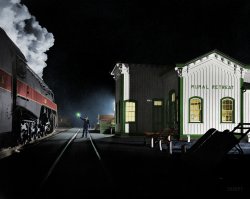
- The Greatest Generation: 1922
- ... in addition to the plentiful sand and that would be the train engine and the metal shovel (which could be made into a lethal weapon if ... Posted by Dave - 08/02/2016 - 10:19am -
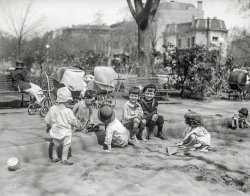
- American Smelting: 1938
- ... Model trains Another photo of someone's outstanding HO train set. Other modelers say odd things like "You've got a nice water tower." ... Posted by Dave - 08/18/2018 - 11:14am -
